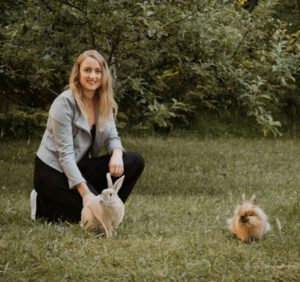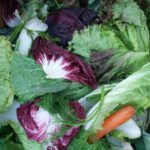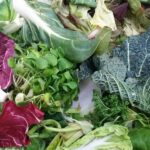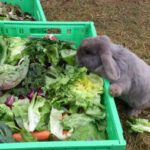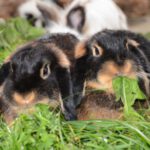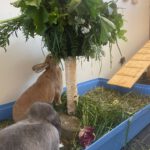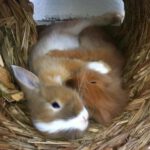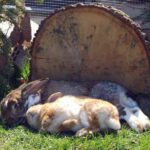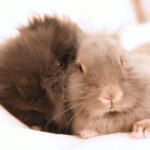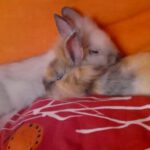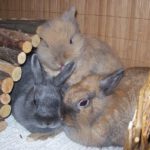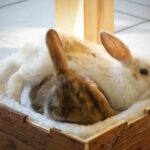Contents
- Coccidiosis (infection with coccidia), Eimeriosis
- Species
- Forms of Coccidiosis in Rabbits
- Hepatic Coccidiosis / Biliary Coccidiosis
- Intestinal Coccidiosis
- Diagnosis: How Are Coccidia Detected?
- Diagnosis: How Are Coccidia Detected?
- Treatment and Care Measures
- Prevention
- Commonly Used Products
- Nutrition in Coccidiosis
- Hygiene & Disinfection
Coccidiosis (infection with coccidia), Eimeriosis
Coccidiosis is the most common parasitic disease in rabbits. It can cause significant losses in young rabbits at weaning age, and even adult rabbits (especially weakened ones) can become ill.
Coccidia are single-celled parasites that live in the gastrointestinal tract of rabbits, where they reproduce and damage the intestines during their development cycle. Numerous species of coccidia are found in rabbits, all of which belong to the genus Eimeria. These single-celled parasites are unfortunately widespread, both in breeding farms and private rabbit care.
Species
Many species of coccidia from the Eimeria genus have been identified in rabbits: Eimeria stiedai, Eimeria magna, Eimeria perforans, Eimeria media, Eimeria irresidua, Eimeria piriformis, Eimeria coecicola, Eimeria elongata, Eimeria intestinalis, Eimeria matsubajashii, Eimeria nagpurensis, and others.
The coccidia differ in their pathogenic properties: These properties depend on the reproduction cycles of the coccidia in the intestines (called merogony). In particular, species of coccidia that go through multiple merogonies (e.g., Eimeria flavescens / Eimeria intestinalis) are possibly more harmful than other coccidia species. Furthermore, the development of noticeable coccidiosis also depends on other factors, such as whether multiple species of coccidia are parasitizing the rabbit simultaneously, damaging various sections of the intestines. The extent of the infestation and whether bacterial secondary infections (e.g., with Escherichia coli strains or Clostridium spp.) are present also play a role in the severity of the disease.
However, mixed infections with different species of coccidia are also often present!
Causes
- Rabbits often get infected with intestinal coccidia as young animals from their mother, in pet stores, or from contact with other rabbits or contaminated food/soil (e.g., meadows inhabited by wild rabbits as a food source). Rabbits from mass breeding (pet stores, small animal markets) are often heavily infected.
- Prevent infestations by taking a fecal sample to the vet or sending it to a lab before introducing a new rabbit to the group. Additionally, a fecal sample should be checked before any vaccinations, if infection is suspected, and at least once a year. Heavy coccidia infestations can affect the effectiveness of the vaccine.
- Stress can cause a rapid increase in coccidia, such as through introductions, disharmonious groups, moves, frequent handling, rough treatment, solitary housing, lack of space (cage or hutch housing), vet trips, or new environments. Previously symptom-free animals may suddenly fall ill.
- Feeding can create an imbalance in the gut, e.g., when rabbits are not primarily fed with greens, but with dry food (pellets, mixed feed, lots of grains/seeds), treats, too much root vegetables/fruit, or other unsuitable food.
- A one-sided diet encourages coccidia, especially when overly cautious feeding is done (rabbits need many secondary plant compounds to stay healthy, and toxicity from dogs, cats, horses, or humans is often misapplied to rabbits, which are not affected in the same way).
- If the ground (in the outdoor run) is heavily contaminated (overcrowded grazing areas, unhygienic hutch floor, soil, poor hygiene), the immune system may no longer be able to keep up, and the balance tips. On well-covered areas (meadows), this problem is usually less significant. Muddy and earthy areas should be avoided. Ideal are hygienic floors in the enclosed hutch (e.g., paving stones) and pasture rotation during outdoor play.
- Wild rabbits can infect domestic rabbits if they have access to the meadow.
- The Megacolon syndrome promotes coccidia.
- Poor hygiene and infrequent cleaning can promote coccidia.
- Do not place food directly on the ground, to avoid contact with feces (use hay racks), and clean the water and food containers daily.
- A compromised gut flora, e.g., due to medications, anesthesia, early separation from the mother, genetic diseases, or stress, provides an ideal breeding ground for coccidia.
- Other diseases often weaken the rabbit so that coccidia can spread.
- In young animals, coccidia may even appear without clear cause during growth, but especially during weaning and when moving to a new home, an outbreak can occur.
- A moist (and also humid) or poor stall climate, as well as damp bedding and rainy weather, promote coccidiosis. Do the rabbits have enough covered and dry areas, or are they exposed to the weather?
- Plenty of movement ensures healthy digestion and helps prevent coccidia.
Forms of Coccidiosis in Rabbits
In rabbits, two forms of coccidiosis are distinguished: hepatic coccidiosis (liver) and intestinal coccidiosis.
Hepatic Coccidiosis / Biliary Coccidiosis
This form is more of a biliary coccidiosis, as the parasites multiply in the bile ducts of the liver. The disease is caused by biliary coccidia (Eimeria stiedai). The parasitic stages enter the intestines via bile fluid and are excreted with the feces. These so-called „oocysts,“ excreted with the feces, can remain infectious in the external environment for months under moist and warm conditions. Transmission occurs through the oral ingestion of these stages from the external environment (e.g., through contaminated food). When rabbits become infected with these pathogens, they may show signs of illness such as liver problems, diarrhea, and digestive disturbances. This form primarily affects older, adult rabbits: it specifically targets the liver (hepatic coccidiosis) and leads to swelling and inflammation of the bile ducts. Grayish-white, abscess-like lumps form in the liver. As mentioned, this form often occurs in older animals, causing gradual weight loss and dull fur, with the animals often showing a general decline in condition and eventually eating less. Other symptoms are similar to those of other liver diseases, but hepatic coccidiosis should always be ruled out through a fecal examination (since coccidia are not always excreted) and an ultrasound: More on liver diseases.
Intestinal Coccidiosis
In intestinal coccidiosis, coccidia multiply in the intestinal wall and can cause damage to it. In particular, the two species Eimeria flavescens and Eimeria intestinalis are considered more pathogenic coccidia species. However, mixed infections with other coccidia parasitizing the intestines are also common. Affected rabbits often show digestive disturbances, watery to foul-smelling diarrhea, bloating, and loss of appetite. Deaths can also occur, especially when young rabbits are affected.
Coccidiosis is the most common cause of death in young rabbits. Generally, young rabbits are more susceptible to intestinal coccidia due to their less developed immune system compared to adults. Therefore, female rabbits before pregnancy and weaned rabbits should be thoroughly examined for coccidia and, if detected, treated accordingly.
Intestinal coccidia can also be present without symptoms or visible signs of illness, particularly if the rabbits have developed some immunity or if the infection is caused by less harmful coccidia. Often, all rabbits in a group are infected, but only individual, weakened animals show symptoms!
If the parasites multiply excessively or if a rabbit is stressed or weakened, the disease symptoms of coccidiosis can also develop in adult rabbits.
This condition causes symptoms such as (recurring) stomach dilatation, gas buildup, and stomach overload, less frequently diarrhea (often foul-smelling), increased amounts of cecal droppings, misshapen or mushy feces, weight loss, bloated abdomen, poor feed intake, and other digestive disturbances. Affected young rabbits are often emaciated or show poor or slow development, and mass deaths can occur in young rabbits. In some cases, coccidia can also trigger paralysis, discharge from the mouth and nose, fever, and convulsions in rabbits. In the advanced stages, the rabbit may stop eating or become lethargic. White, thickened areas become visible in the intestines.
Diagnosis: How Are Coccidia Detected?
Coccidia are detected through a fecal sample (using the flotation method). Since coccidia are not consistently shed, the feces must be collected for at least two days, preferably over three days, before being examined. The feces can be analyzed by a veterinarian, or you can send it directly to a laboratory (for example, you can easily mail a fecal sample to www.exomed-shop.de – with the code „Kaninchenwiese24“ you get a 5% discount in the shop).
It is recommended to have rabbits checked for parasites at least once a year, ideally before vaccination. Newly acquired rabbits should definitely be examined for intestinal parasites before being introduced to other animals.
After infection with coccidia, it takes 5 to 10 days for them to be detectable in the feces, or 14 to 18 days for liver coccidia (Eimeria stieda).
Diagnosis: How Are Coccidia Detected?
Coccidia are detected through a fecal sample (using the flotation method). Since coccidia are not consistently shed, the feces must be collected for at least two days, preferably over three days, before being examined. The feces can be analyzed by a veterinarian, or you can send it directly to a laboratory.
It is recommended to have rabbits checked for parasites at least once a year, ideally before vaccination. Newly acquired rabbits should definitely be examined for intestinal parasites before being introduced to other animals.
After infection with coccidia, it takes 5 to 10 days for them to be detectable in the feces, or 14 to 18 days for liver coccidia (Eimeria stieda).
Treatment and Care Measures
Coccidia should not be taken lightly! Timely veterinary treatment is absolutely necessary when dealing with coccidia. Untreated young rabbits can quickly die from coccidiosis or its symptoms, and even weakened or chronically ill adult rabbits often fall victim to coccidiosis. In breeding, it is very common to see mass deaths of young rabbits due to coccidiosis.
Coccidia are treated as soon as they are detectable in the poops.
Particularly new arrivals, animals being rehomed, young rabbits, and breeding rabbits should be tested for coccidia using a poop sample before mating, and even in hobbyist breeding, rabbits should be tested for coccidia before each vaccination to ensure that the vaccination can optimally protect the rabbit!
The veterinarian will prescribe a medication against the coccidia (see below), which doesn’t necessarily need to be given to all rabbits in the group, but only to those with an infection. The veterinarian will provide a recommendation. Make sure the medication is given directly, as medications administered through drinking water or food are often inaccurately dosed (one rabbit may drink more than another).
The following active ingredients are commonly used:
- Toltrazuril (Baycox®, 10-15 mg/kg > 0.2-0.3 ml/kg) is very commonly used, although some rabbits may react to it with food refusal or poor food intake. Only the white liquid (5%) is suitable, as the 2.5% version (transparent) is intended for poultry and is unsuitable for rabbits because it is highly irritating to the mucous membranes. The commonly recommended dosing schedule of 3-3-3 (3 days of treatment, 3 days break, 3 days of treatment) has now been replaced by the 2-5-2 schedule, which is better tolerated (manufacturer’s recommendation).
- Diclazuril (Vecoxan®, 2.5 mg/kg = 1 ml/kg) is a better-tolerated but less well-known medication. However, with large populations and regular use, resistance develops more quickly. Vecoxan is administered to rabbits at 1 ml/kg. In asymptomatic animals with a low infection level, a single dose or two consecutive days of treatment may be sufficient. For strong infestations or symptoms, it is better to follow the 2-5-2 rhythm (2 days of treatment, 5 days break, 2 days of treatment).
- Other medications include:
- Sulfamethoxypyrazine (Davosin®)
- Sulfathiazol (Eleudron®)
- Sulfaquinoxaline (Nococcin®)
- Sulfadimethoxin (Kokzidiol SD®, Retardon®)
- The effectiveness of oregano and garlic against coccidia has been confirmed in a study (see Nosal et al. 2014). According to the study, they have a better effect than Baycox® and lead to better weight gain and the lowest coccidia shedding compared to untreated animals, as well as those treated with Baycox®. Oregano oil is commonly used, and a list can be found below.
Prevention
In addition to veterinary treatment, there are options to support the therapy, and these supplements can also be used preventively.
The following supplements support the gut flora and can indirectly help fight coccidia (or prevent reinfection):
- RodiCare akut, Rodicolan, Colosan, and Herbi Colan
- Offer dandelion juice (available at health food stores, organic shops, or online) for drinking.
- Oregano oil: A very effective option for preventing coccidia and eliminating the parasite from affected populations is oregano oil. It is also used in agriculture, typically via drinking water, and its efficacy has been scientifically proven in studies (Study: Nosal et al. 2014) and confirmed by owner experiences. By the way, the oil also keeps drinking systems free of algae, even in high temperatures. Rabbits usually enjoy the mild oregano taste. If the rabbits drink little, oregano oil can also be added to their food. Combined with regular fecal samples, oregano oil can be a good tool for coccidia prevention.
Caution! Never use pure essential oregano oil! The oils for food and water are highly diluted (10%) and should only be added to water and food drop by drop.
Commonly Used Products
Feed Oils
- Probac Brockamp Oregano Oil: 5ml oil per 1kg of food, 2-3 times/week, approximately €39.00/l
- ROPA-B FEEDING OIL 2%: 5ml per kg of food, for 4-5 days per week, €15.95/l
- ROPA Poultry Feeding Oil: 5ml per kg of food, for 4-5 days per week, approximately 500ml/€14 = €28/l
- Röhnfried Darmwohl 250ml, €12.50 ( €38/l)
Drinking Water Oils (with emulsifier) – Are the rabbits drinking enough?
(These can also be mixed into the food or sprayed over the food.)
- Ropadiar Solution Oregano Oil 10%, 2-3ml per 10 liters of water, approximately €39.90/l
- ROPA-B LIQUID 10%, 15ml per 10 liters of drinking water, for 3-4 days per week, approximately €49.95/l
- DOSTO® Liquid 10%, approximately 20ml per 1 liter of water, €25/250ml or approximately €53.50/l
- Dosto WG Ropa Liquid 12%, 1ml per 3 liters of drinking water, approximately €26/300ml
- Becker Enterosan Liquid, 5ml per 10 liters of water, €24.50/250ml
- Röhnfried UsneGano Oregano-Bartflechten-Mix, 3%, 3ml per 1 liter of drinking water, approximately €46/l, daily or 2-3 times per week, 3ml/liter of water
- Procura® 10% solution, 5-20ml per 10 liters of water
Administration Tips:
- Spray the diluted oregano drinking water oil onto the leafy greens using a clean plant sprayer.
- Soak Cuni Complete in oregano oil-water mixture.
- Mix oregano oil into their favorite food.
Nutrition in Coccidiosis
When dealing with coccidia, it is important to provide a strengthening diet that supports gut health, focusing on herbs that promote a healthy digestive tract. Recommended herbs include oregano (or its cultivated form, marjoram), thyme, wormwood, dandelion, yarrow, parsley, tansy, sage, oak branches (bark and leaves), black cumin, and blueberry plants. Additionally, other herbs that support the stomach and intestines should be included.
Fresh green fodder is also important—grasses in summer and leafy vegetables in winter, such as bitter salads, Swiss chard, spinach, carrot greens, and celery stalks. Furthermore, tannin-rich tree bark and branches from species such as willow, hazelnut, oak, ash, fruit trees, fir, spruce, and pine can be beneficial.
For underweight rabbits, avoid offering oats, as they often trigger yeast growth. Expand the variety of plants and herbs to provide a comprehensive, healthy diet for recovery.
Hygiene & Disinfection
During treatment, hygiene is crucial to prevent reinfection, especially in the litter boxes and feeding areas where rabbits can repeatedly contract coccidiosis.
- Hay and fresh greens should be offered in a rack to prevent contamination with feces.
- Water and food bowls must be thoroughly cleaned daily with hot water (over 60°C) or in the dishwasher (using a hot program).
- Feces should be removed at least once a day to prevent the ingestion of sporulated oocysts, as these develop after one to four days. Litter boxes should be rinsed with boiling water to ensure proper disinfection.
- The enclosure, especially areas contaminated with feces, should be kept simple during treatment, with the litter corners cleaned daily. Any areas that have been soiled must be thoroughly cleaned mechanically or treated with heat (above 60°C, e.g., boiling water from a kettle). The rest of the enclosure should be cleaned thoroughly once or twice during the treatment phase. The floor should be wiped (for indoor enclosures) or treated with a steam cleaner or hot water (above 60°C). For outdoor enclosures, a hose, boiling water, high-pressure cleaner, or steam cleaner (above 60°C) should be used to rinse and clean the area. However, steam cleaners can also create a warm, humid environment that may promote the growth of coccidia, as not all spores are killed, and the remaining ones thrive.
- Fabric items like blankets and carpets can be washed in a machine at high temperatures (at least 60°C). These should be removed from the enclosure during the course of medication treatment.
- If the enclosure has a soil floor, the top layer should be removed, and paving slabs should be laid down to prevent future coccidia outbreaks. As a temporary measure, the soil can be flooded with boiling water. Additionally, careful use of quicklime is possible (but the rabbits must not be allowed into the treated area during and immediately after this process).
- Outdoor enclosures on the grass should be moved after treatment, and the old area should not be grazed for some time. Additionally, the area can be treated with quicklime or a weed burner. In general, such areas should not be overgrazed (keep the stocking density low), and pasture rotation should be considered.
- Excessive hygiene measures, such as disinfection, limiting free-range access, or boiling and cooking equipment, are unnecessary. These actions cause stress to both the animals and their caretakers, and they can weaken the immune system.
- Common disinfectants are ineffective against coccidia. Suitable disinfectants include cresols, such as those found in Neopredisan disinfectants (when diluted to 3-4% and left to act for at least 2 hours). Capha DesClean is no longer effective against coccidia. However, these disinfectants are highly toxic to rabbits, irritate their mucous membranes, and should only be used on surfaces that can be wiped clean (PVC, tiles, etc.). Surfaces that the disinfectant could seep into (such as wood, carpets, and fabric) should not be used by the rabbits afterward, as they will be toxic. Wipeable surfaces must be thoroughly cleaned of disinfectant residue after use. Rabbits must be removed from the area, and the space should be ventilated for an extended period afterward. These disinfectants are also not recommended for indoor use and can be dangerous for individuals with allergies or asthma. Therefore, disinfection is only recommended if done with a steam cleaner (above 60°C), a flame device, or boiling water. It is important to expose the surfaces to heat for a little longer and quickly ventilate the humid-warm air afterward. Boiling water is the simplest, most affordable, and effective disinfectant.
Sources:
Abu-Akkada, S. S., Oda, S. S., Ashmawy, K. I. (2010): Garlic and hepatic coccidiosis: prophylaxis or treatment?
Bauer, C. (2006): Parasitosen des Kaninchens. In: Boch J., Supperer R.. Herausgeber: Schnieder, T. Veterinärmedizinische Parasitolige. 6. Auflage. Parey, Stuttgart. P. 561-575.
Baker D.G. (2007): Parasites of Laboratory Animals. Second Edition. American College of Laboratory. Animal Medicine, Blackwell Publishing, New Dehli.
Beck W., Pantchev N. (2006): Praktische Parasitologie bei Heimtieren. Kleinsäuger. Vögel. Reptilien.
Bienen. Schlütersche, Hannover.
Beck, W., Pantchev, N. (2009): Magen-Darm-Parasiten beim Kaninchen–Erregerbiologie, Pathogenese, Klinik, Diagnose und Bekämpfung. Kleintierpraxis 11.5 278-288.
Eckert J, Friedhoff KT, Zahner P, Deplazes P. (2008): Lehrbuch der Parasitologie für die Tiermedizin. 2. Aufl. Enke; Stuttgart
Ewringmann, A. (2009): Kotuntersuchung beim Kaninchen. Tierarzthelfer/in konkret, 5(02), 16-17.
Ewringmann, A. (2017): Leitsymptome beim Kaninchen: Diagnostischer Leitfaden und Therapie. Georg Thieme Verlag
Gugołek A., Kowalska D., Konstantynowicz M., Strychalski J., Bukowska B. (2011): Performance indicators, health status and coccidial infection rates in rabbits fed diets supplemented with white mustard meal.
Hein, J. (2016): Durchfall beim Kaninchen–Ursachen und Therapie. kleintier konkret, 19(S 01), 2-9.
Hein, J. (2017): Durchfallerkrankungen bei Kleinsäugern: Ursache, Diagnostik, Therapie. Schlütersche.
Kowalska D., Bielański P., Nosal P., Kowal J. (2012): Natural alternatives to coccidiostats in rabbit nutrition.
Kühn, T. (2003): Kokzidien des Kaninchens (Oryctolagus cuniculus)-Verlauf natürlicher Infektionen bei Boden-und Käfighaltung in einer Versuchstiereinheit.
Nosal, P., Kowalska, D., Bielanski, P., Kowal, J., & Kornas, S. (2014): Herbal formulations as feed additives in the course of rabbit subclinical coccidiosis. Annals of parasitology, 60(1).
Schmäschke R. (2013): Die koproskopische Diagnostik von Endoparasiten in der Veterinärmedizin. Schlütersche; Hannover
Schmäschke, R. (2014): Parasitologische Kotuntersuchung des Kaninchens. kleintier konkret, 17(S 01), 31-33.
Starkloff, A. 2010: Einfluss von Wetterfaktoren und sozialer Umwelt auf den Endoparasitenbefall juveniler Wildkaninchen (Oryctolagus cuniculus L.) Diss. University of Bayreuth
Zinke, J. (2004): Ganzheitliche Behandlung von Kaninchen und Meerschweinchen: Anatomie, Pathologie, Praxiserfahrungen; 14 Tabellen. Georg Thieme Verlag


